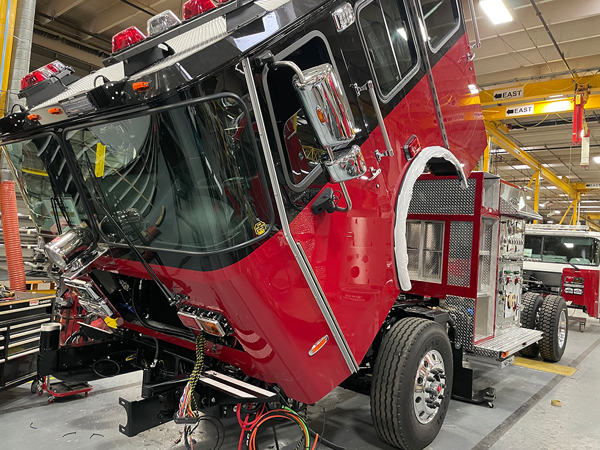Updated production photos of a new engine being built or Evergreen Park

E-ONE photo
Feb 7
Posted by Admin in Fire Department News, Fire truck being built | Comments off
Feb 7
Posted by Admin in Apparatus on-scene, Fire Scene photos | 1 Comment
From Tim Olk:
Chicago Fire Department Still & Box Alarm Fire 1058 N Karlov

Tim Olk photo
Tags: Chicago FD Tower Ladder 14, Chicago firemen battle house fire in frigid temperatures, Chicago firemen fight house fire in sub zero temperatures, house fire in Chicago, Still and Box Alarm fire in Chicago, Tim Olk, winter fire scene photos
Feb 7
Posted by Admin in Fire Department History | 2 Comments
Another installment about History of Evanston Fire Department
On December 5, 1897, a lamp exploded in the engine room of the steamer Morley, which was 1,000 tons, 193 feet long, with a crew of 12, located on Lake Michigan 1/2-mile offshore of Evanston. The subsequent fire was seen and reported by the resident of 305 Davis Street, and the EFD responded as Chief Sam Harrison called for “City of Evanston No. 1” and all the hose in town.
After the steamer and the hose carts arrived, Harrison, alone, went out to the stricken ship aboard the Northwestern University Life Saving Crew’s surf boat, dragging nearly a 1/2-mile (2,500 feet) of hose behind. Upon arrival, he was told by the crew that the boilers could explode at any moment. Disregarding the warning, Harrison attacked the blaze, and actually extinguished the fire in one of the coal bunkers. As he was about to drown the other bunker, the flames swept past him, and he was forced to abandon ship! The blaze raged for another eight hours, attracting a large crowd on the beaches of Evanston. Chief Harrison and all twelve members of the Morley’s crew escaped without injury.
On August 22, 1899, fire heavily-damaged the residence of Judge Harvey B. Hurd and destroyed several surrounding structures at Davis & Ridge. Judge Hurd, a powerful and influential town resident who had served as the first Evanston Town Board President in 1864, was highly critical of the performance of the Evanston Fire Department at the fire. First of all, the steam fire engine was not dispatched to the initial alarm, and then the Waterworks engineer did not increase pressure in the mains when it was needed.
A subsequent investigation by the Evanston City Council determined that existing policies were followed, but that the policies needed to be changed. Henceforth, the steam fire engine would respond to all alarms of fire, and water-pressure would be increased in the mains whenever a fire was reported to the EFD, even before the fire was confirmed. In 1912, this second policy contributed to the eventual collapse of some of the city’s water mains, and to the abandonment of the use of direct-pressure (plug-pressure), except in extraordinary cases.
Another ancillary result of the investigation into the Hurd fire was a determination by the city council that more manpower and a third fire station were needed, and so in 1900 they appropriated $10,000 for the construction of a fire station in North Evanston to be located within 1/4 mile of the C&NW RR Central Street depot. With construction of Fire Station # 3, a fire station now was located within 1/4 mile of each of the three C&NW RR depots. On January 31, 1901, a horse-drawn hose wagon, two horses, and three full-time, paid firemen were assigned to the new Fire Station # 3 at 2504 West Railroad Avenue, which was later known as Green Bay Road, in North Evanston. A third firefighter was assigned to the hose company at Station # 2 in South Evanston. Also, the chief was provided with a horse-drawn buggy and a buggy driver who also served as the chief’s secretary.
So Evanston’s firefighting force was increased to 19, with twelve firemen now at Station # 1, three at Station # 2, three at Station # 3, plus the chief located either in his office at Station # 1 or at his residence. In 1901, the number of horses in service with the EFD was increased to 14, ten at Station # 1, two at Station # 2, and two at Station # 3. Station #1 apparatus consisted of the Ahrens Metropolitan 2nd size steamer, one two-axle four-wheeled hose wagon, the venerable Babcock chemical engine, the Davenport H&L (the only ladder truck in town), and the chief’s buggy. All five rigs were fitted with a two-horse hitch. The companies at both stations # 2 & # 3 operated with a two-axle, four-wheeled hose wagon, both of which were fitted with a two-horse hitch. The three hose wagons (one at each of the three fire stations) were the backbone of the EFD from 1901-07. Each was equipped with 1,250 feet of first-class 2-1/2 inch hose line, various types of nozzles, fire extinguishers, and hand-tools, with direct-pressure (plug-pressure) still being used on a routine basis.
To read all the installments of this history, click HERE
Tags: Ahrens Metropolitan 2nd size steamer, Evanston Fire Chief S. C. “Carl” Harrison Jr, Evanston Fire Department history, Judge Harvey B. Hurd, Phil Stenholm
You are currently browsing the archives for Sunday, February 7th, 2021

For the finest department portraits and composites contact Tim Olk or Larry Shapiro.
Arclite theme by digitalnature | powered by WordPress